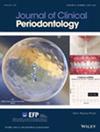颊骨壁厚度决定了种植体植入后垂直颊骨丢失的程度:一项临床前研究
IF 6.8
1区 医学
Q1 DENTISTRY, ORAL SURGERY & MEDICINE
引用次数: 0
摘要
目的探讨不同颊骨壁厚度愈合部位种植体植入后的颊垂直骨吸收情况。材料与方法在11头小型猪的半颌愈合骨中植入3个锥形杂交钛种植体。根据颊骨壁厚度随机分为三组:G1 (1.0 mm)、G2 (1.0 - 1.5 mm)和G3 (1.5 mm)。动物分别于24小时、2周、4周和8周实施安乐死。进行组织学和组织计量学分析。主要结果是从加工过的和中等粗糙的种植体表面之间的过渡点(TP)到第一个骨-种植体接触(fBIC)的垂直距离。结果愈合过程平稳。2周时,所有组均出现口腔吸收,但G3组表现出更早的骨附着和更少的吸收征象。8周时,G1组所有种植体表面均出现中等粗糙暴露,G3组只有1个种植体表面出现暴露。8周时TP‐fBIC值分别为0.92±0.63 mm (G1)、0.27±0.54 mm (G2, p = 0.041)和- 0.16±0.17 mm (G3, p = 0.0002)。骨与种植体的接触随着时间的推移而增加。结论较薄的颊骨壁(1 mm)有较大的垂直骨丢失和种植体表面暴露,而厚的颊骨壁(1.5 mm)能较好地保留颊骨并保护种植体表面。本文章由计算机程序翻译,如有差异,请以英文原文为准。
Buccal Bone Wall Thickness Dictates the Extent of Vertical Buccal Bone Loss Following Implant Placement: A Preclinical Study
AimTo assess buccal vertical bone resorption following implant placement in healed sites with varying buccal bone wall thicknesses.Materials and MethodsIn 11 miniature pigs, three tapered hybrid titanium implants were placed per hemi‐maxilla in healed bone. Sites were randomised into three groups based on buccal bone wall thickness: G1 (< 1.0 mm), G2 (1.0–1.5 mm) and G3 (> 1.5 mm). Animals were euthanised at 24 h and 2, 4 or 8 weeks. Histological and histometric analyses were performed. The primary outcome was the vertical distance from the transition point (TP) between the machined and moderately rough implant surfaces to the first bone‐to‐implant contact (fBIC).ResultsHealing was uneventful. At 2 weeks, all groups showed buccal resorption, although G3 exhibited earlier bone apposition and fewer resorptive signs. By 8 weeks, all G1 implants displayed exposure of the moderately rough surface, while only one implant in G3 showed exposure. TP‐fBIC values at 8 weeks were 0.92 ± 0.63 mm (G1), 0.27 ± 0.54 mm (G2, p = 0.041) and −0.16 ± 0.17 mm (G3, p = 0.0002). Bone‐to‐implant contact increased over time across all groups.ConclusionThin buccal bone walls (< 1 mm) were associated with greater vertical bone loss and implant surface exposure, whereas thick walls (> 1.5 mm) preserved the buccal bone better and protected the implant surface.
求助全文
通过发布文献求助,成功后即可免费获取论文全文。
去求助
来源期刊

Journal of Clinical Periodontology
医学-牙科与口腔外科
CiteScore
13.30
自引率
10.40%
发文量
175
审稿时长
3-8 weeks
期刊介绍:
Journal of Clinical Periodontology was founded by the British, Dutch, French, German, Scandinavian, and Swiss Societies of Periodontology.
The aim of the Journal of Clinical Periodontology is to provide the platform for exchange of scientific and clinical progress in the field of Periodontology and allied disciplines, and to do so at the highest possible level. The Journal also aims to facilitate the application of new scientific knowledge to the daily practice of the concerned disciplines and addresses both practicing clinicians and academics. The Journal is the official publication of the European Federation of Periodontology but wishes to retain its international scope.
The Journal publishes original contributions of high scientific merit in the fields of periodontology and implant dentistry. Its scope encompasses the physiology and pathology of the periodontium, the tissue integration of dental implants, the biology and the modulation of periodontal and alveolar bone healing and regeneration, diagnosis, epidemiology, prevention and therapy of periodontal disease, the clinical aspects of tooth replacement with dental implants, and the comprehensive rehabilitation of the periodontal patient. Review articles by experts on new developments in basic and applied periodontal science and associated dental disciplines, advances in periodontal or implant techniques and procedures, and case reports which illustrate important new information are also welcome.
 求助内容:
求助内容: 应助结果提醒方式:
应助结果提醒方式:


